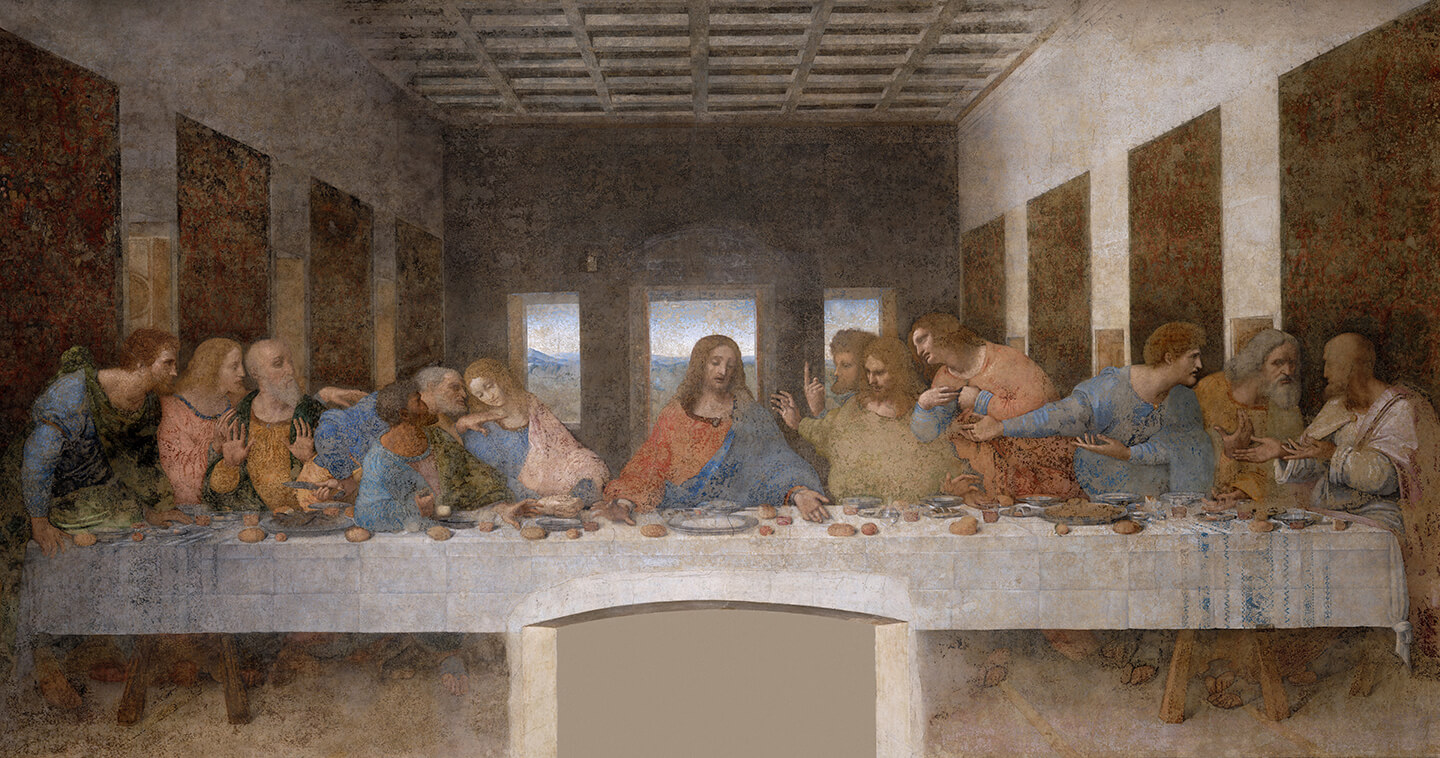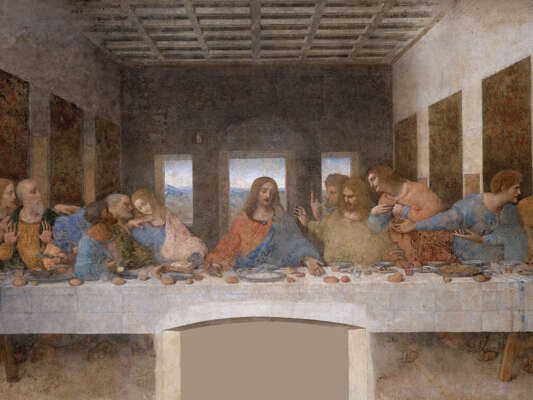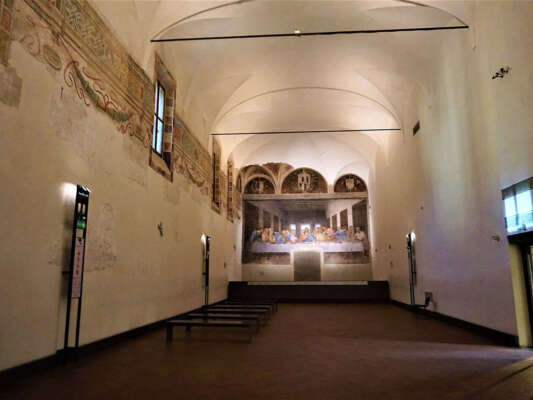In this free full guide, you will learn about The Last Supper by Leonardo da Vinci, located in the center of Milan, Italy. Join us on an unforgettable journey through the history and secrets of this inspiring painting.
The Last Supper – Free Full Guide
Editor’s Choice
Vatican City Free Audio Guide
Notre-Dame de Paris Free Audio Guide
Louvre in Paris – Free Audio Guide
The Last Supper (Italian: il Cenacolo or L’Ultima Cena) is a mural painting by the Italian High Renaissance artist Leonardo da Vinci, dated 1495 – 1498. It is housed in the refectory of the Convent of Santa Maria delle Grazie in Milan, Italy.
The painting represents the scene of the Last Supper of Jesus with the 12 Apostles, as it is told in the Gospel of John – specifically the moment after Jesus announces that one of his apostles will betray him.
Its handling of space, mastery of perspective, treatment of motion, and complex display of human emotion have made it one of the Western world’s most recognizable paintings and among Leonardo’s most celebrated works. Some specialists consider it pivotal in considering the transition into what is now termed the High Renaissance.
You can enjoy the world’s most famous mural painting in the Santa Maria delle Grazie church (or “Holy Mary of Grace”) in Milan. It’s a beautiful church, a convent for monks and nuns, and a part of the UNESCO World Heritage.
The apse and Dome are made in the Renaissance style, while the nave is in Gothic style. The church has plenty of beautiful paintings, murals, important religious attributes, and sculptures.
The Last Supper is located on one of the walls of the refectory (dining hall for monks).
The work was commissioned as part of a plan of renovations to the church and its convent buildings by Leonardo’s patron Ludovico Sforza (Duke of Milan). To permit Leonardo’s inconsistent painting schedule and frequent revisions, it is painted with materials that allowed for regular alterations: egg tempera on gesso, pitch, and mastic. Due to this, a variety of environmental factors, and intentional damage, little of the original painting remains today despite numerous restoration attempts.
The Last Supper measures 460 by 880 cm (or 180 by 350 inches) and covers an end wall of the dining hall at the monastery, although the room was not a refectory at the time that da Vinci painted it. The main church building was completed around the same time as the painting – in 1498.
Some stories say that the monastery complained about the delay from Leonardo’s side. Da Vinci explained he had been struggling to find the perfect villainous face for Judas, but now he would possibly use the features of those who had complained.
Also, Leonardo’s friend Bernardo Zenale advised him to leave Christ’s face slightly unfinished, arguing that “it would be impossible to imagine faces lovelier or gentler than those of James the Greater or James the Less.” Leonardo apparently took the advice.
Rather than using the proven method of painting on walls, Leonardo painted The Last Supper in tempera, the medium generally used for panel painting. The painting is on a stone wall sealed with a double layer of gesso, pitch, and mastic. Then he added an undercoat of white lead to enhance the brightness of the tempera that was applied on top.
The Last Supper portrays the reaction given by each apostle when Jesus said one of them would betray him.
As it is said in the bible: “Jesus was deeply moved and declared: «Truly, truly, I say to you, one of you will betray me». The disciples looked at each other, not knowing who he was talking about. Now one of the disciples, the one Jesus loved, was at the table next to Jesus. Simon Peter nodded to him and said: «Say, who is he to whom he refers?». And he, thus reclining on Jesus’ chest, said to him: “Lord, who is he?”. Jesus then replied: “He is the one for whom I will dip a morsel and give it to him.” And having dipped the morsel, he took it and gave it to Judas Iscariot, son of Simon.”
All 12 apostles have different reactions to the news, with various degrees of anger and shock.
The figure of Jesus (in the middle) divides the painting into 2 parts (6 apostles on each side).
If you look carefully you will also notice that each group of 6 is in its turn divided into smaller groups by 3.
The first group of 3 on the left side is: Bartholomew, James, and Andrew. They are all surprised.
The second group of 3 on the left side is: Judas Iscariot, Peter, and John. The main figure here is Judas. He looks withdrawn and taken aback by the sudden revelation of his plan. He is clutching a small bag, perhaps signifying the silver given to him as payment for betraying Jesus. He is also tipping over the salt cellar. The near-Eastern expression “betray the salt” means to betray one’s master. He is the only person to have his elbow on the table and his head is also vertically the lowest of anyone in the painting. Peter wears an expression of anger and appears to be holding a knife, foreshadowing his violent reaction. Peter is leaning toward John and touching him on the shoulder, in reference to John’s Gospel where he signals the “beloved disciple”. The youngest apostle, John, appears to swoon and lean towards Peter.
Thomas, James, and Philip are the next group of 3. Thomas is clearly upset; the raised index finger foreshadows his incredulity about the Resurrection. James looks stunned, with his arms in the air. Meanwhile, Philip appears to be requesting some explanation.
Matthew, Jude Thaddeus, and Simon are the final group of 3. Both Thaddeus and Matthew are turned toward Simon, perhaps to find out if he has any answer to their initial questions.
In common with other depictions of the Last Supper from this period, Leonardo seats the diners on one side of the table, so that none of them has his back to the viewer.
Most previous depictions by previous authors excluded Judas by placing him alone on the opposite side of the table from the other eleven disciples and Jesus or placing halos around all the disciples except Judas. Leonardo instead has Judas lean back into the shadow.
Jesus is predicting that his betrayer will take the bread at the same time he does to Thomas and James the Greater to his left, who react in horror as Jesus points with his left hand to a piece of bread before them. Distracted by the conversation between John and Peter, Judas reaches for a different piece of bread not noticing Jesus too stretching out with his right hand towards it.
The angles and lighting draw attention to Jesus, whose turned right cheek is located at the vanishing point for all perspective lines. In addition, the painting demonstrated Da Vinci’s masterful use of perspective as it “draws our attention to the face of Christ at the center of the composition, and Christ’s face, through his down-turned gaze, directs our focus along the diagonal of his left arm to his hand and therefore, the bread.”
While the painting was being executed, Leonardo’s friend, the mathematician Luca Pacioli, called it “a symbol of man’s burning desire for salvation”.
In Davinci’s notes and notebooks, we can see that he made lots of different sketches and compositions, trying to find the perfect option to depict the scene.
It is interesting to know that 2 early copies of The Last Supper are known to exist, presumed to be works by Leonardo’s assistants (1 – by Giampietrino and the second by Cesare da Sesto). The copies are almost the size of the original and have survived with a wealth of original detail still intact. There is also the 3rd copy by Andrea Solari dated 1520, which is very close to the original painting.
Even though the masons filled the walls with moisture-retaining rubble, the painting was done on a thin exterior wall, so the effects of humidity were felt keenly. In less than 60 years (in 1556) the mural turned into a “muddle of blots”. It was so deteriorated that the figures were almost unrecognizable.
In 1652 it was so bad, that a doorway was cut through the painting, and later bricked up. This can still be seen as the irregular arch-shaped structure near the center base of the Last Supper.
The first restoration was in 1726 by Michelangelo Bellotti, who simply filled in missing sections with oil paint and then varnished the whole mural.
The second attempt was in 1770 by the artist named Giuseppe Mazza. He stripped off Bellotti’s work and then largely repainted the painting.
In 1796, French revolutionary anti-clerical troops used the refectory as an armory and stable. They threw stones at the painting and climbed ladders to scratch out the Apostles’ eyes.
After 1800 the room was used as a prison.
In 1821, Stefano Barezzi, an expert in removing frescoes from their walls intact, was called in to remove the painting to a safer location. However, he badly damaged the center section before realizing that Leonardo’s work was not a fresco. Barezzi then attempted to reattach damaged sections with glue.
From 1901 to 1908, Luigi Cavenaghi first completed a careful study of the structure of the painting and then began cleaning it. In 1924, Oreste Silvestri did further cleaning and stabilized some parts.
During World War II, on the night of 15 August 1943, an Allied aerial bombardment hit the church and the convent. Much of the refectory was destroyed, but some walls survived, including the one that holds The Last Supper, which had been sand-bagged to protect it. Some preservation works are done to maintain it for the future.
Between 1946 and 1954, Mauro Pellicioli undertook a clean-and-stabilise restoration. The painting became relatively darker and more colorful.
From 1978 to 1999, Pinin Brambilla Barcilon guided a major restoration project. They bricked up the windows and the refectory was converted to a sealed, climate-controlled environment. They stabilized the wall, removed the dirt, and reversed previous unsuccessful restoration attempts.
Barcilon conducted scientific studies using an infrared resectoscope and microscopic core samples to determine the precise original form of the painting. Some areas were deemed unrestorable and were re-painted using watercolor in subdued colors intended to indicate they were not original work, while not being too distracting.
This restoration took 21 years and in 1999, the painting was returned to display.
To see the Last Supper by Leonardo da Vinci in Milan (Italy) you can book tickets on the official website. They will cost around 15 euros per person.
The Santa Maria delle Grazie church (the location of the painting) is just a 25-minute walk from Milan’s Cathedral. We have a separate video fully dedicated to this beautiful place, which is officially the biggest church in Italy.
Travel Tips and Takeaways.
One of the most famous and recognizable works of Leonardo da Vinci – the mural “The Last Supper” is located in Milan (Italy) on the wall of the dining room of the church dedicated to the Holy Mary.
The size of the painting is 40.48 square meters. It is more than the size of 6 snooker tables together.
When visiting the church, it’s important to respect the dress code, which generally requires modest clothing that covers shoulders and knees as a mark of respect.
Photography is strictly prohibited inside the room housing the Last Supper to preserve the artwork.
The Last Supper is just 1 of the attractions in the church. For example, the beautiful cloister. It’s a serene and picturesque area that’s often less crowded.
Plan to visit other nearby sites like the Sforza Castle or the Milan Cathedral on the same day to make the most of your trip.




